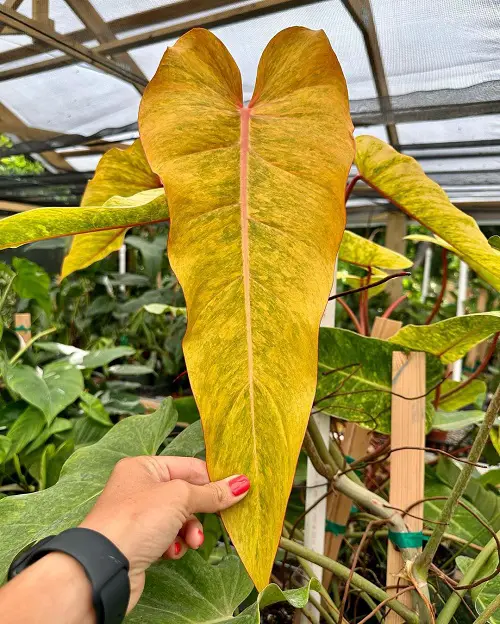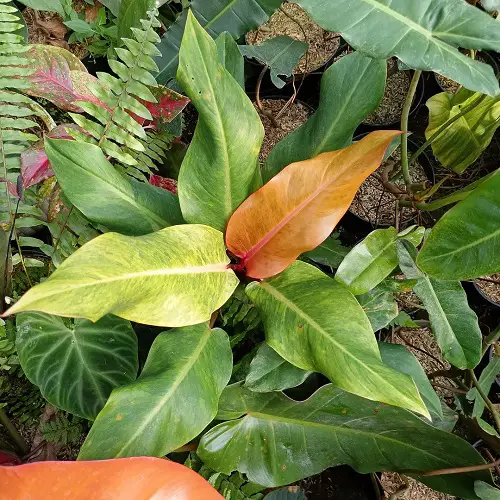Watch vibrant foliage flourish with our amazing How to Grow and Care for Philodendron Orange Marmalade guide.
Here is How to Grow and Care for Philodendron Orange Marmalade! Learn the ideal conditions, watering techniques, and pruning methods to ensure stunning foliage that will captivate any indoor or outdoor space.
Philodendron Orange Marmalade Information

The Philodendron Orange Marmalade is a member of the Araceae family, commonly known as the Aroid family. This tropical plant is native to the rainforests of South America and is loved by plant enthusiasts for its striking appearance and unique characteristics.
With its vibrant foliage, the ‘Orange Marmalade’ stands out among other houseplants. Its large, heart-shaped leaves feature a mesmerizing blend of orange, yellow, and green hues, resembling the colors of a delicious marmalade. The leaves have a glossy texture, adding an extra touch of elegance to their appeal.
Philodendron Orange Marmalade has the ability to change leaf color depending on light exposure. When exposed to bright indirect light, the leaves display vibrant orange and yellow tones. In lower light conditions, the foliage may turn green, adapting to its surroundings.
Propagating Philodendron Orange Marmalade from Cuttings

To propagate Philodendron Orange Marmalade through stem cutting, you can follow these steps:
- Select a healthy stem from the Philodendron Orange Marmalade plant and make a clean cut just below a node using a sharp, sterilized knife or pruners.
- Remove any lower leaves or nodes along the stem, leaving a few leaves at the top intact.
- Apply a rooting hormone to the cut end of the stem to encourage faster root development.
- Fill a small pot with well-draining, moistened soil or a suitable rooting medium like perlite or vermiculite.
- Make a planting hole in the soil and insert the cut end of the stem, ensuring it is securely positioned.
- Place the potted cutting in a warm and brightly lit area, avoiding direct sunlight.
- Maintain consistent moisture levels in the soil, but avoid overwatering, as it can lead to rot.
Propagation Tip: You can cover the potted cutting with a plastic bag or create a mini greenhouse effect using a clear plastic dome to help retain moisture and promote successful rooting. Keep an eye on the cutting for new growth and roots, and once well-established, transplant it into a larger pot or desired location.
Best Pot for Philodendron Orange Marmalade
When selecting a pot for your Philodendron Orange Marmalade, it’s important to consider the plant’s growth habits and requirements. For optimum growth, choose a pot that accommodates the current root system of your philodendron plant. Initially, a 4-6 inch (10-15 cm) diameter pot works well for young plants.
As your plant matures, gradually re-pot the plant into a one size bigger pot than the old one, depending on its spread.
Here are Plant Pot Sizes from Inches to Gallon
Requirements for Growing Philodendron Orange Marmalade

Sunlight
This Philodendron thrives in bright, indirect sunlight. Place it near a window with filtered light or in a spot where it receives gentle, indirect sunlight throughout the day.
Avoid exposing the plant to direct sunlight, as it can scorch the leaves. A location with consistent, moderate light levels is ideal for maintaining the plant’s vibrant foliage.
Soil
Provide well-draining soil for your Philodendron Orange Marmalade. A mixture of peat moss, perlite, and a high-quality potting mix works well. This combination ensures adequate moisture retention without waterlogging the roots.
Here are the best recipes to make the perfect growing medium for your plants
Good drainage is essential to prevent root rot and maintain plant health.
Watering
Water your Philodendron Orange Marmalade thoroughly when the top inch (2.5 cm) of soil feels dry to the touch. Ensure that excess water drains out of the pot, as this plant prefers slightly moist but not soggy conditions.
Avoid overwatering to prevent root rot. Adjust the watering frequency based on environmental conditions and the moisture needs of the plant, always allowing the soil to dry out between waterings partially.
Here are Signs of Overwatering & How to Save an Overwatered Plant
Temperature and Humidity
Philodendron Orange Marmalade prefers average room temperatures between 65-85°F (18-29°C). Protect it from extreme temperature fluctuations and drafts.
This plant thrives in moderate to high humidity levels, which mimic its natural rainforest habitat. If the air in your home is dry, consider increasing humidity by using a humidifier, placing the pot on a tray filled with pebbles and water, or misting the leaves regularly. Adequate humidity helps prevent leaf browning and encourages healthy growth.
Check out these 10 Ways To Increase Humidity For Houseplants That Work
Philodendron Orange Marmalade Care

Fertilizer
Feed your Philodendron Orange Marmalade with a balanced, water-soluble houseplant fertilizer during the growing season (spring and summer) to promote healthy growth. Dilute the fertilizer to half the recommended strength and apply it every 4-6 weeks.
Avoid fertilizing during the dormant period (fall and winter) when the plant’s growth slows down.
Here are the Best DIY Potassium Fertilizer Recipes
Pruning
Regular pruning helps maintain the shape and size of your Philodendron Orange Marmalade while promoting new growth. Trim any yellowed, damaged, or leggy leaves using clean and sterilized pruning shears. You can also prune back overgrown vines to encourage branching and denser foliage.
Additionally, remove any dead or decaying plant material to prevent the risk of pests or diseases. Pruning can be done throughout the year as needed.
Pests and Diseases
Philodendron Orange Marmalade is generally resilient to pests and diseases, but it’s still important to monitor and address any issues promptly. Common pests include mealybugs, aphids, and spider mites.
Click here to learn the Amazing Natural Pesticide Recipe that can Kill any Pest
Treat infestations with insecticidal soap or neem oil, ensuring thorough coverage of both sides of the leaves. Maintain good airflow and avoid overwatering to prevent fungal diseases like root rot or leaf spot.
If necessary, use fungicides specifically formulated for houseplants, following the instructions carefully. Regularly inspect the plant for any signs of pests or diseases and take appropriate measures as soon as they are detected.


